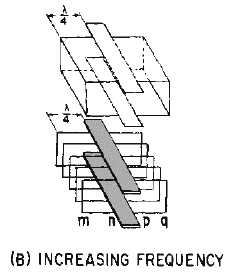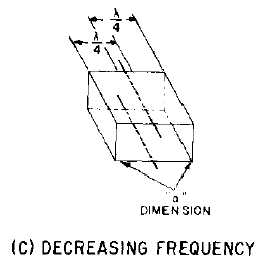1-9
Figure 1-10B.—Frequency effects on a waveguide. INCREASING FREQUENCY.
Figure 1-10C.—Frequency effects on a waveguide. DECREASING FREQUENCY.
If the frequency of a signal is decreased so much that two quarter-wavelengths are longer than the
wide dimension of a waveguide, energy will no longer pass through the waveguide. This is the lower
frequency limit, or CUT-OFF FREQUENCY, of a given waveguide. In practical applications, the wide
dimension of a waveguide is usually 0.7 wavelength at the operating frequency. This allows the
waveguide to handle a small range of frequencies both above and below the operating frequency. The "b"
dimension is governed by the breakdown potential of the dielectric, which is usually air. Dimensions
ranging from 0.2 to 0.5 wavelength are common for the "b" sides of a waveguide.
Q-9. At very high frequencies, what characteristics are displayed by ordinary insulators?
Q-10. What type of insulator works well at very high frequencies?



